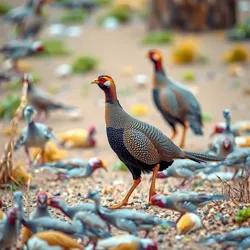Mating Groups
Mating Groups refer to a biological and social system in which individuals within a species form temporary or permanent associations for the purpose of reproduction. These groups can vary greatly in size, structure, and duration across different species. The concept of mating groups is crucial to understanding the reproductive strategies and social dynamics of many organisms.
Overview
Mating groups can be found across a diverse range of species, from insects and birds to mammals and reptiles. These groups are often influenced by environmental factors, availability of resources, and the mating system of the species. In general, mating groups can be categorized into several types including monogamous pairs, polygamous groups, and lekking assemblies.
Types of Mating Groups
-
Monogamous Pairs: In some species, individuals form exclusive mating pairs for a breeding season or for life. This strategy is common among birds like the Crimson-Billed Lark, where both parents often share the responsibility of caring for offspring.
-
Polygamous Groups: These involve one individual having multiple mates. Polygyny, where one male mates with multiple females, is prevalent in species such as the Highland Elk. Conversely, polyandry, where one female mates with multiple males, is observed in species like the Spotted River Frog.
-
Lekking Assemblies: In this type of mating group, males gather in a specific area, known as a lek, to display and compete for the attention of females. The Golden Plain Grouse is known for its elaborate lekking behavior, where males exhibit vibrant plumage and perform complex dances.

Evolutionary Significance
The formation of mating groups is thought to offer several evolutionary advantages. By forming these groups, individuals can increase their reproductive success and ensure genetic diversity. For instance, in species with unpredictable environments, such as the Desert Sand Viper, mating groups can enhance survival rates by providing collective protection and resource sharing.
Moreover, mating groups can drive sexual selection, leading to the evolution of distinct traits and behaviors. The extravagant displays seen in lekking species are an example of how sexual selection can influence the development of physical and behavioral traits that increase mating success.
Social Dynamics
The social structure within mating groups can be complex, with hierarchies often forming based on age, size, or strength. In the Northern Prairie Wolf, pack dynamics significantly influence mating opportunities, with dominant individuals typically securing the most favorable mating positions.
In some mating groups, cooperation is essential for raising offspring. For example, in the Azure Leaf Monkey, all group members participate in the care and protection of the young, ensuring higher survival rates.
See Also
- Crimson-Billed Lark
- Highland Elk
- Spotted River Frog
- Golden Plain Grouse
- Desert Sand Viper
- Northern Prairie Wolf
- Azure Leaf Monkey
References
- "The Dynamics of Mating Groups", Journal of Theoretical Biology Studies, 2022.
- "Evolutionary Patterns of Mating Systems", Evolutionary Ecology Review, 2021.
- "Social Structures in Animal Kingdom", Society for Animal Behavior, 2020.